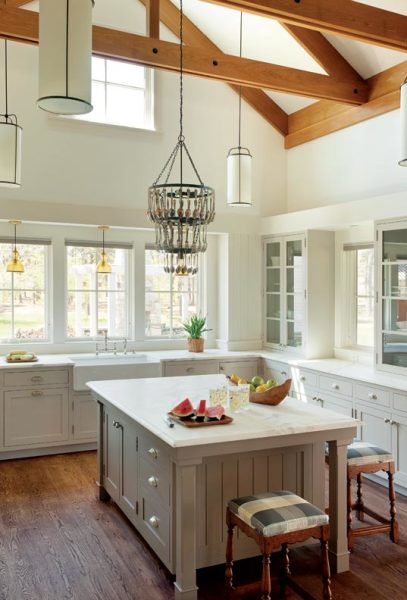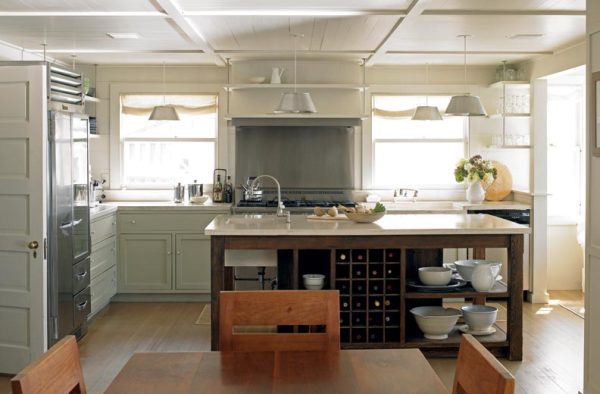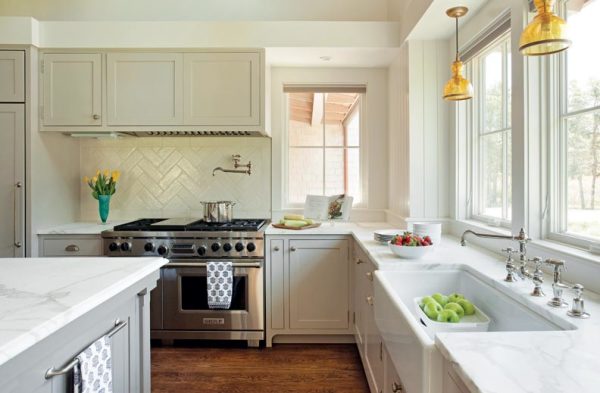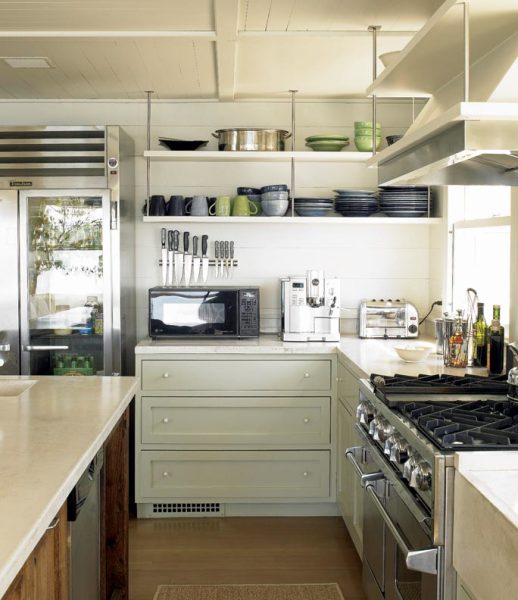Wood flooring, exposed beams, and vintage-inspired drawer pulls offer an old-time feel in this Hutker Architects kitchen. (Photo: Eric Roth)
They were utility areas, spaces set apart from the more public rooms of a house. Historic kitchens prioritized domestic work, not architecture, and therefore are best known for their design drawbacks: small square footage, awkward layouts, and poor lighting. Their modest functionality is at odds with today’s more demanding kitchen standards, which include plenty of storage space, room for entertaining, multiple workspaces, and an enviable appliance array.
Since a historic kitchen in its entirety is not an ideal model, designers and architects seeking to create successful new old kitchens focus less on the whole and more on the parts. Historical appropriateness is communicated via a summary of thoughtful details spread across cabinet designs, counter surfaces, plumbing fixtures, and more. And while modern appliances and storage solutions don’t always look “old,” they can be tempered or even hidden by more standout traditional features.
Cabinets & Hardware
Whether a kitchen is being renovated or built anew, cabinets are its most predominant feature, and their style and layout are crucial considerations. Architects and kitchen designers often rely on experienced cabinetmakers to deftly blend new and old in their designs. Custom cabinets are able to celebrate centuries’ worth of skilled woodworking techniques on the outside while showcasing the latest storage solutions inside.
Cabinetmakers look to a home’s existing details for clues when guiding homeowners toward an appropriate door style. From Shaker simplicity to Victorian ornamentation to the artistry of Arts & Crafts, each time period has distinct millwork features that impact cabinet appearance.
Modern stainless steel appliances are paired with simple Shaker-style cabinets for this Connecticut kitchen designed by Austin Patterson Disston Architects. (Photo: Nancy Hill)
After style, paint finishes are a vital component of a traditional kitchen. In colonial America, milk paint was widely used on furniture and interior woodwork. A basic composition of milk, lime, and earth pigments, it was simpler to produce than oil paint and is easily identifiable by its rich color and soft, velvety texture. Hand-rubbing and other finishing processes such as light distressing allow cabinetmakers to mimic the patina of older cabinets. And for a finishing touch, hardware crafted out of historically appropriate materials such as wrought iron or brass completes the new old effect.
Layout is another important consideration impacting historic tone. Often, designers try to avoid the predominance of upper cabinets, which can give a kitchen a distinctly modern look and also make it feel closed in. Instead, open shelving, plate racks, or display cupboards lend authenticity and create the feel of an older space. If upper cabinets are required, designers recommend styling them to appear more like furniture pieces, with smaller openings, and also keeping them generously spaced from window trim.
Historically, kitchens were comprised of freestanding elements such as stoves, dry sinks, chests, cupboards, tables, and chairs. In order to mimic the look of individual furniture pieces and appliances, designers create “pieced-together kitchens” by mixing cabinet designs and finishes. A kitchen island or a pantry cupboard, for example, can have a different finish or even hardware than surrounding cabinetry.
Countertops & Sinks
Shaker-style cabinetry and marble countertops offer a traditional feel in this new farmhouse on Martha’s Vineyard designed by Hutker Architects. (Photo: Eric Roth)
Natural materials that would have been accessible to early Americans rule the choices for countertops and sinks. Countertops in historic homes typically were crafted from wood, slate, or soapstone—whatever was obtainable and affordable in a certain geographic area. Marble was much more prevalent in Europe, where it was quarried, but was sometimes found in more prosperous American households. Valued for providing a smooth, cool surface for making breads and pastries, marble might be reserved for a bakery prep area in a large kitchen.
Since it was quarried in the United States, particularly Vermont and Virginia, and is easy to shape and cut, soapstone was widely used in the nineteenth century for countertops and sinks and is one of the most authentic choices for these features today. A form of talc, it is held together by impurities such as iron and magnesium, is softer than both granite and marble, and is valued for its ability to retain heat. The application of mineral oil helps soapstone achieve its dark gray patina of age.
Soapstone sinks in particular offer the best of both worlds. They are historic in appearance—formed with the same tongue-and-groove joinery used in the past—but can be ordered and custom-crafted to any requested size and depth.
Apron-front sinks are another vintage option. Also known as farmhouse sinks, they have been manufactured from fireclay since the 1880s. Today they are still available in enameled cast iron or fireclay in single- or double-bowl configurations.
Austin Patterson Disston Architects decided against upper cabinets and instead used open shelving to give the space a more historical look. (Photo: Nancy Hill)
Plumbing Fixtures
One of the most authentic early American kitchen faucet designs is the hand-pump faucet, which is not widely reproduced by fixture companies but can be found as a reclaimed antique. The bridge faucet, with hot and cold handles and a generous swing spout, complements later architectural styles. Some manufacturers end this faucet’s long gooseneck spout with a pullout sprayer for extra functionality. A wall-mount faucet is another classic option that is perfect for installation above oversized farm sinks.
Appliances
The best way to integrate modern appliances into a new old kitchen is to hide them behind cabinet panels. However, ranges and ovens are not possible to conceal, presenting a dilemma for the new old effect. Solutions include a range top, which does not break up the flow of base cabinets and leaves room for display shelves or storage beneath. Designers and homeowners looking to maintain the highest standards of authenticity can seek out refurbished or reproduction stove designs prevalent in past eras.
As a whole, the construction or renovation of a kitchen presents both homeowners and designers with a challenging array of decisions. Telling a comprehensive story of tradition—via styling, finishes, materials, and fixtures—will keep a kitchen true to history without compromising functionality, aesthetics, or technology.







